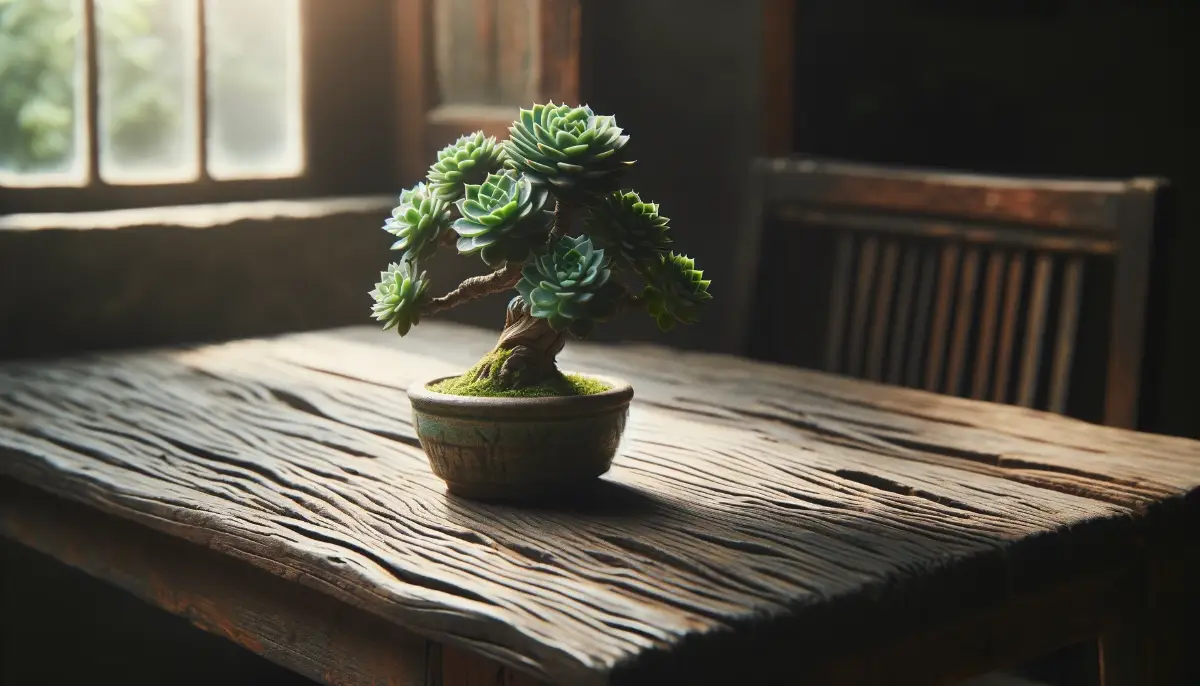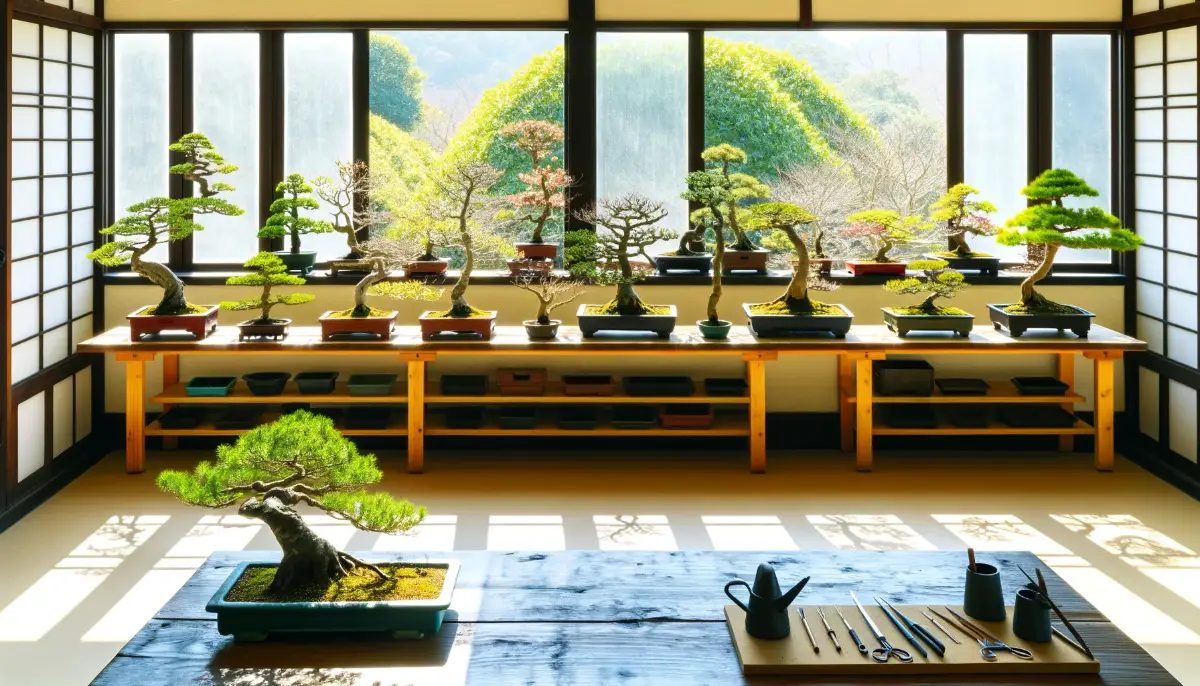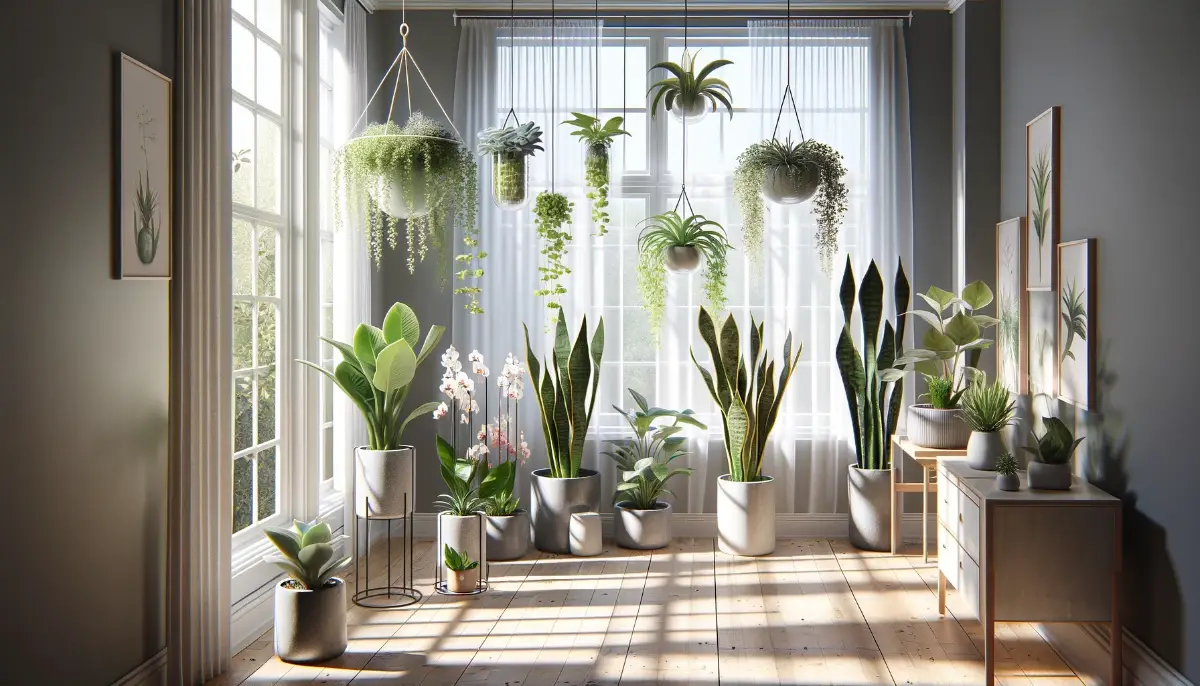Discover the enchanting world of succulent bonsai trees, where the rugged beauty of succulents meets the meticulous art of bonsai. This guide is your doorway to mastering the craft of nurturing these compact, resilient plants in your own home.
Ideal for both novices and seasoned plant enthusiasts, succulent bonsai offer a unique twist on traditional gardening that is both visually striking and wonderfully low-maintenance. Dive into the fascinating process of shaping, watering, and caring for these living sculptures that bring a piece of nature’s serenity right to your tabletop or windowsill.
What is a Succulent Bonsai
A succulent bonsai combines the resilience and unique aesthetics of succulents with the ancient art of bonsai. Unlike traditional bonsai, which often involves trees like pines, maples, or junipers, succulent bonsai uses drought-resistant succulents.
This practice adheres to many of the traditional bonsai techniques, including pruning, wiring, and careful attention to aesthetic detail, but it is adapted to the unique requirements and characteristics of succulents.
Origins and Concept
The concept of succulent bonsai is relatively modern compared to the centuries-old tradition of classical bonsai. It emerged as enthusiasts sought more versatile and less demanding plants for the bonsai practice, suitable for arid environments and indoor settings where traditional bonsai trees might struggle.
Differences from Traditional Bonsai
- Watering Needs: Succulent bonsai require less frequent watering than their traditional counterparts, making them easier to care for, especially in dry conditions.
- Growth Habits: Succulents generally grow slower and can thrive in smaller pots with minimal soil, aligning well with the bonsai practice of restricting growth to create miniature landscapes.
- Aesthetic Variations: While traditional bonsai often mimic the appearance of aged trees, succulent bonsai offer a variety of unusual shapes and textures due to the diverse forms of succulents available.
Selecting the Right Succulent for Bonsai
When choosing a succulent for bonsai, consider the following aspects to ensure you pick a species that will thrive under bonsai cultivation:
- Growth Pattern: Look for succulents with a natural tendency to grow woody stems or trunks, as these will lend themselves better to traditional bonsai shaping techniques.
- Size and Scale: Consider the mature size of the succulent. Smaller varieties are typically easier to maintain as bonsai.
- Resilience: Since bonsai involves restrictive and sometimes stressful techniques like pruning and wiring, choosing a resilient succulent is crucial.
Best Succulent Species for Bonsai Beginners
Jade Plant (Crassula ovata)
- Characteristics: Jade plants have thick, woody stems and glossy green leaves, resembling a miniature tree. Their growth can be easily controlled through pruning.
- Care Tips: Jade plants need bright light and moderate watering. They are very forgiving and can tolerate infrequent watering.
Elephant Bush (Portulacaria afra)
- Characteristics: This succulent resembles a small tree, with woody stems and small, glossy leaves. It is often used in bonsai for its tree-like structure.
- Care Tips: Elephant Bush prefers sunny locations and dry conditions. It’s particularly drought-tolerant and requires well-draining soil.
Echeveria
- Characteristics: Echeverias are rosette-forming succulents that come in a variety of colors and patterns. They make for picturesque bonsai subjects due to their symmetrical form.
- Care Tips: They thrive in well-lit conditions and require occasional watering, making sure the soil is completely dry between watering sessions.
Hens and Chicks (Sempervivum)
- Characteristics: Sempervivum forms tight clusters of rosettes. The parent rosette (Hen) produces new smaller rosette offsets (Chicks), which can be cultivated into separate bonsai.
- Care Tips: These plants are extremely hardy, needing minimal watering and capable of surviving in colder temperatures than most succulents.
Aloe Species
- Characteristics: Aloes have thick, fleshy leaves and often feature unique colors and markings. They can grow into structured, tree-like shapes with proper care.
- Care Tips: Aloes require bright light and should be watered deeply but infrequently, allowing the soil to dry out between waterings.
Techniques Used in Succulent Bonsai
Pruning Techniques for Succulent Bonsai
Pruning is not just about maintaining size; it’s also about shaping your succulent bonsai to mimic the mature appearance of traditional trees. Here are some tips on how to approach pruning:
- Timing: The best time to prune most succulents is during their active growth period, which is typically in the spring and summer. This allows the plant to heal quickly and minimize stress.
- Technique: Use sharp, clean scissors or pruning shears. Make cuts just above a leaf node or along the stem to encourage branching. Remove any dead or overgrown branches to improve light exposure and air circulation within the plant.
- Goal: Aim to create a balanced look that enhances the plant’s natural structure. Pruning should promote a thick trunk and evenly spaced branches that resemble a miniature tree.
Wiring Techniques for Shaping Succulent Bonsai
Wiring is a traditional bonsai technique adapted for use with succulents to guide their growth and shape them artistically:
- Materials: Use soft-coated wires or special bonsai wires that are gentle on the succulent’s soft tissues to avoid damage.
- Application: Carefully wrap the wire around the branches or trunk, avoiding tight loops that can cut into the plant as it grows. The idea is to guide, not constrict.
- Monitoring: Keep an eye on the wired parts to ensure they do not grow into the plant. Remove or adjust the wiring as needed, usually after a few months, depending on the succulent’s growth rate.
Soil and Repotting Essentials for Succulent Bonsai
The right soil mix and timely repotting are crucial for the health of succulent bonsai:
- Soil Mix: Use a well-draining mix specifically designed for succulents or cacti. It should contain components like coarse sand, perlite, and organic matter to ensure good drainage and air flow to the roots.
- Repotting Frequency: Succulents generally require repotting every two to three years to refresh the soil and prevent nutrient depletion. This is also a good time to trim the roots gently, which encourages healthier, more compact growth.
- Procedure: When repotting, be gentle with the root system. Trim any excessively long or rotting roots. Ensure the new pot is slightly larger than the old one and has good drainage holes.
Helpful Articles:
When and How to Repot Your Indoor Plants
How to Make Your Own Organic Soil
Understanding and implementing these detailed care aspects will greatly enhance your ability to cultivate and maintain a healthy, visually appealing succulent bonsai. These techniques not only keep your plant healthy but also contribute to the artistic element of bonsai, turning your succulent into a living sculpture.
Getting Started with Your First Succulent Bonsai
To start your journey with succulent bonsai, here’s a simple guide:
- Select Your Plant: Choose one of the beginner-friendly species listed above.
- Prepare the Pot and Soil: Use a shallow bonsai pot with a drainage hole and a well-draining soil mix.
- Planting: Plant your succulent, positioning it so the base of the plant is just above the soil surface.
- Initial Pruning: Trim any overly long roots and shape the plant lightly to encourage a visually pleasing structure.
- Ongoing Care: Place the bonsai in a location with plenty of indirect sunlight and water sparingly, especially during the winter months.
Starting with these beginner-friendly succulents, you can learn the basics of bonsai care and gradually advance to more complex projects as you gain confidence and experience.
Creative Styling Tips for Succulent Bonsai
Selecting the Right Container
- Aesthetics: Choose a container that complements the color and form of your succulent. Traditional bonsai pots are shallow and wide, which helps emphasize the miniature tree appearance.
- Material: Opt for materials like ceramic or clay that offer good drainage and have a natural look.
Positioning Your Succulent
- Angle: Plant your succulent at a slight angle to create a more dynamic, natural appearance, mimicking how trees often grow in nature.
- Centering: Avoid placing the succulent exactly in the center of the pot; slightly off-center positioning can make the composition more interesting and visually pleasing.
Pruning for Shape
- Formative Pruning: Early in the plant’s life, focus on forming the primary shape. Remove any disproportionate growths that disrupt the desired tree form.
- Maintenance Pruning: Regularly prune to maintain the shape and encourage denser growth at the top and along the branches.
Using Moss and Top Dressing
- Moss: Adding moss around the base of your succulent can enhance the miniature landscape effect, adding texture and color contrast.
- Top Dressing: Use stones, gravel, or colored sand as a top dressing to stabilize the plant and add to the overall aesthetics.
Wiring for Branch Training
- Gentle Bending: Use soft wires to gently bend and position branches. This can help your succulent develop a more traditional bonsai silhouette.
- Regular Adjustment: As your succulent grows, regularly adjust or remove the wires to prevent them from cutting into the flesh.
Ensuring Healthy Growth
Sunlight and Watering
- Sunlight: Ensure your succulent bonsai receives plenty of indirect sunlight. If the sunlight is too intense, it can cause scorching, so filtered light is ideal.
- Watering: Water deeply but infrequently, allowing the soil to dry out completely between watering sessions. This mimics the natural dry conditions most succulents thrive in.
Fertilization and Soil Health
- Fertilizer: Use a balanced, water-soluble fertilizer at half strength during the growing season to provide essential nutrients without overfeeding.
- Soil Check: Annually check the soil pH and nutrient levels to ensure they are optimal for succulent growth.
Common Issues in Succulent Bonsai Care and Troubleshooting Tips
Overwatering
- Symptoms: Soft, mushy leaves or stem, leaves falling off easily, and signs of rot.
- Solution: Reduce watering frequency. Ensure the soil is completely dry before watering again. If rot has set in, consider repotting the plant into fresh, dry soil and remove any rotted parts with a sterile knife.
Underwatering
- Symptoms: Shriveled, wrinkled leaves, dry and brittle appearance.
- Solution: Increase watering frequency slightly, especially during hot, dry months. Deep watering is key to rejuvenate an underwatered succulent.
Insufficient Light
- Symptoms: Stretching toward the light source, pale or weak growth, larger gaps between leaves.
- Solution: Move your succulent bonsai to a brighter location. If natural light is insufficient, consider using a grow light to provide the necessary spectrum and intensity.
Pest Infestations
- Common Pests: Mealybugs, spider mites, and aphids.
- Solution: Isolate the affected plant to prevent spread to other plants. Use a soft cloth dipped in alcohol to wipe off pests, or apply an appropriate insecticidal soap or neem oil solution. Regular inspections are crucial for early detection and management.
Nutrient Deficiencies
- Symptoms: Poor growth, discolored leaves, and overall lack of vigor.
- Solution: Apply a balanced, water-soluble fertilizer at half strength every month during the growing season. Avoid over-fertilization, which can be just as harmful.
Preventative Care and Maintenance
Maintaining a healthy succulent bonsai also involves regular preventative care to avoid these common issues:
- Regular Inspection: Regularly check your succulent for signs of pests and diseases. Early detection makes treatment more effective.
- Proper Pruning: Not only helps shape the plant but also improves airflow, which is vital for preventing fungal infections.
- Adequate Spacing: If growing multiple succulent bonsais, ensure they have enough space between them to promote good air circulation and reduce the risk of disease spread.
FAQs About Succulent Bonsai Trees
What is a succulent bonsai tree?
A succulent bonsai tree combines the drought-tolerant nature of succulents with the artistic shaping techniques of traditional bonsai. They are ideal for creating miniature landscapes with less maintenance and care compared to traditional bonsai trees.
How do I choose the right succulent for bonsai?
Select succulents that naturally have a woody stem or can be trained to form a tree-like structure, such as Jade Plants, Aloe, or Elephant Bush. Look for plants that are healthy, free from pests, and have a shape that appeals to you.
How often should I water my succulent bonsai?
Water only when the soil is completely dry. The frequency depends on the environment, but typically, it involves less frequent watering than most other plants. Overwatering is a common issue, so ensure good drainage.
What type of soil is best for succulent bonsai?
Use a well-draining soil mix designed for succulents and cacti. The mix should contain components like coarse sand, perlite, and organic matter to facilitate proper drainage and aeration.
Can I use regular bonsai techniques on succulents?
While many traditional bonsai techniques can be applied, adjustments are often necessary to accommodate the softer tissues and moisture requirements of succulents. Techniques like gentle wiring and conservative pruning are recommended.
How much light does a succulent bonsai need?
Succulent bonsais require plenty of bright, indirect light. Direct sunlight can sometimes be too harsh, causing the leaves to scorch, while insufficient light can lead to etiolation (stretching out).
How do I prune a succulent bonsai?
Prune during the plant’s active growth period, typically in spring or early summer. Focus on maintaining shape and removing unhealthy parts. Use sharp, clean tools to make precise cuts.
What are common pests of succulent bonsai, and how do I deal with them?
Common pests include mealybugs, spider mites, and aphids. Treat infestations promptly with alcohol wipes, insecticidal soap, or neem oil, and isolate affected plants to prevent the spread of pests.
How do I repot my succulent bonsai?
Repot your succulent bonsai every two to three years or when the plant outgrows its container. Use fresh succulent mix and trim the roots gently if they are overly long or tangled.
What should I do if my succulent bonsai starts to look unhealthy?
Identify symptoms such as drooping, discoloration, or pests. Adjust care routines focusing on watering practices, light exposure, and soil condition. If the problem persists, consult more detailed resources or a professional.
External Links:
https://en.wikipedia.org/wiki/History_of_bonsai









